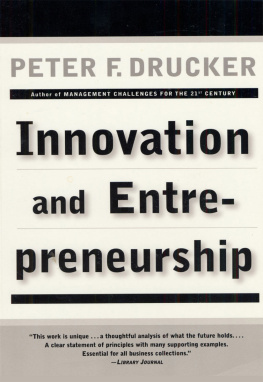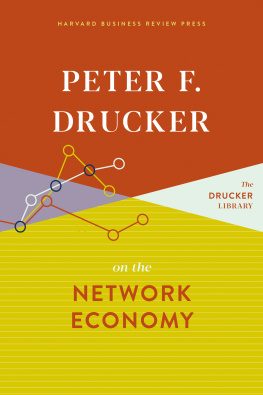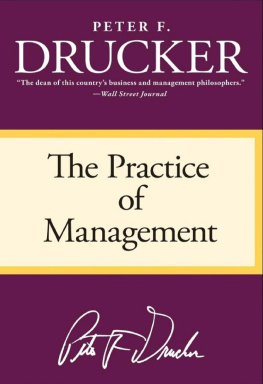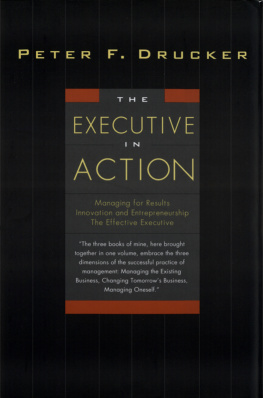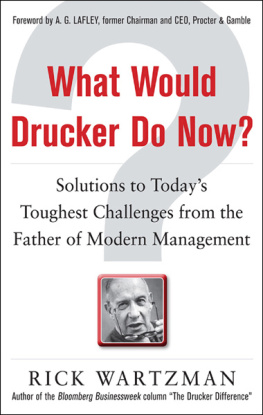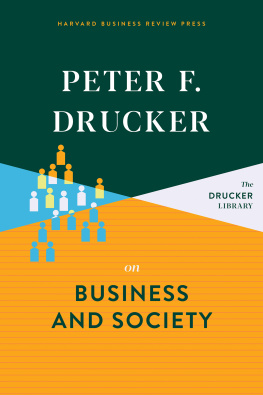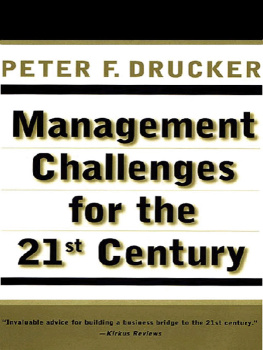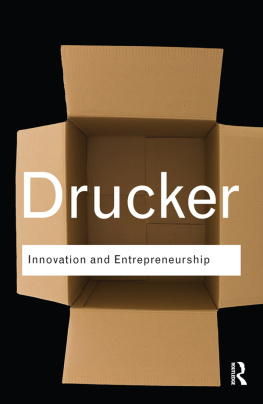This book presents innovation and entrepreneurship as a practice and a discipline. It does not talk of the psychology and the character traits of entrepreneurs; it talks of their actions and behavior. It uses cases, but primarily to exemplify a point, a rule, or a warning, rather than as success stories. The work thus differs, in both intention and execution, from many of the books and articles on innovation and entrepreneurship that are being published today. It shares with them the belief in the importance of innovation and entrepreneurship. Indeed, it considers the emergence of a truly entrepreneurial economy in the United States during the last ten to fifteen years the most significant and hopeful event to have occurred in recent economic and social history. But whereas much of todays discussion treats entrepreneurship as something slightly mysterious, whether gift, talent, inspiration, or flash of genius, this book represents innovation and entrepreneurship as purposeful tasks that can be organizedare in need of being organizedand as systematic work. It treats innovation and entrepreneurship, in fact, as part of the executives job.
This is a practical book, but it is not a how-to book. Instead, it deals with the what, when, and why; with such tangibles as policies and decisions; opportunities and risks; structures and strategies; staffing, compensation, and rewards.
Innovation and entrepreneurship are discussed under three main headings: The Practice of Innovation; The Practice of Entrepreneurship; and Entrepreneurial Strategies. Each of these is an aspect of innovation and entrepreneurship rather than a stage.
Part I on the Practice of Innovation presents innovation alike as purposeful and as a discipline. It shows first where and how the entrepreneur searches for innovative opportunities. It then discusses the Dos and Donts of developing an innovative idea into a viable business or service.
Part II, The Practice of Entrepreneurship, focuses on the institution that is the carrier of innovation. It deals with entrepreneurial management in three areas: the existing business; the public-service institution; and the new venture. What are the policies and practices that enable an institution, whether business or public-service, to be a successful entrepreneur? How does one organize and staff for entrepreneurship? What are the obstacles, the impediments, the traps, the common mistakes? The section concludes with a discussion of individual entrepreneurs, their roles and their decisions.
Finally, Part III, Entrepreneurial Strategies, talks of bringing an innovation successfully to market. The test of an innovation, after all, lies not its novelty, its scientific content, or its cleverness. It lies in its success in the marketplace.
These three parts are flanked by an Introduction that relates innovation and entrepreneurship to the economy, and by a Conclusion that relates them to society.
Entrepreneurship is neither a science nor an art. It is a practice. It has a knowledge base, of course, which this book attempts to present in organized fashion. But as in all practices, medicine, for instance, or engineering, knowledge in entrepreneurship is a means to an end. Indeed, what constitutes knowledge in a practice is largely defined by the ends, that is, by the practice. Hence a book like this should be backed by long years of practice.
My work on innovation and entrepreneurship began thirty years ago, in the mid-fifties. For two years, then, a small group met under my leadership at the Graduate Business School of New York University every week for a long evenings seminar on Innovation and Entrepreneurship. The group included people who were just launching their own new ventures, most of them successfully. It included mid-career executives from a wide variety of established, mostly large organizations: two big hospitals; IBM and General Electric; one or two major banks; a brokerage house; magazine and book publishers; pharmaceuticals; a worldwide charitable organization; the Catholic Archdiocese of New York and the Presbyterian Church; and so on.
The concepts and ideas developed in this seminar were tested by its members week by week during those two years in their own work and their own institutions. Since then they have been tested, validated, refined, and revised in more than twenty years of my own consulting work. Again, a wide variety of institutions has been involved. Some were businesses, including high-tech ones such as pharmaceuticals and computer companies; no-tech ones such as casualty insurance companies; world-class banks, both American and European; one-man startup ventures; regional wholesalers of building products; and Japanese multinationals. But a host of nonbusinesses also were included: several major labor unions; major community organizations such as the Girl Scouts of the U.S.A. or C.A.R.E., the international relief and development cooperative; quite a few hospitals; universities and research labs; and religious organizations from a diversity of denominations.
Because this book distills years of observation, study, and practice, I was able to use actual mini-cases, examples and illustrations both of the right and the wrong policies and practices. Wherever the name of an institution is mentioned in the text, it has either never been a client of mine (e.g., IBM) and the story is in the public domain, or the institution itself has disclosed the story. Otherwise organizations with whom I have worked remain anonymous, as has been my practice in all my management books. But the cases themselves report actual events and deal with actual enterprises.
Only in the last few years have writers on management begun to pay much attention to innovation and entrepreneurship. I have been discussing aspects of both in all my management books for decades. Yet this is the first work that attempts to present the subject in its entirety and in systematic form. This is surely a first book on a major topic rather than the last wordbut I do hope it will be accepted as a seminal work.
Claremont, California
Christmas 1984
The Entrepreneurial Economy
I
Since the mid-seventies, such slogans as the no-growth economy, the deindustrialization of America, and a long-term Kondratieff stagnation of the economy have become popular and are invoked as if axioms. Yet the facts and figures belie every one of these slogans. What is happening in the United States is something quite different: a profound shift from a managerial to an entrepreneurial economy.
In the two decades 1965 to 1985, the number of Americans over sixteen (thereby counted as being in the work force under the conventions of American statistics) grew by two-fifths, from 129 to 180 million. But the number of Americans in paid jobs grew in the same period by one-half, from 71 to 106 million. The labor force growth was fastest in the second decade of that period, the decade from 1974 to 1984, when total jobs in the American economy grew by a full 24 million.
In no other peacetime period has the United States created as many new jobs, whether measured in percentages or in absolute numbers. And yet the ten years that began with the oil shock in the late fall of 1973 were years of extreme turbulence, of energy crises, of the near-collapse of the smokestack industries, and of two sizable recessions.
The American development is unique. Nothing like it has happened yet in any other country. Western Europe during the period 1970 to 1984 actually lost jobs, 3 to 4 million of them. In 1970, western Europe still had 20 million more jobs than the United States; in 1984, it had almost 10 million less. Even Japan did far less well in job creation than the United States. During the twelve years from 1970 through 1982, jobs in Japan grew by a mere 10 percent, that is, at less than half the U.S. rate.

